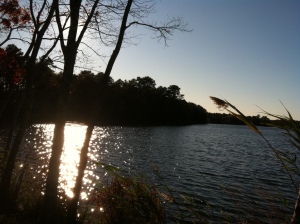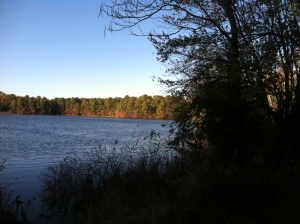This photo was taken last Sunday at a lake near my home.
And, so was this.
On one hand these shots might seem entirely similar. Same lake, different angle. But if you stop (even briefly!) to attend to the these two shots, it will soon become clear that the differences are numerous. Same lake, different angle, each offering something distinct.
But suppose you were going to take two minutes to study the differences between these two shots. How could two minutes enable you to become completely absorbed in studying the details? Is it enough time to notice more than you might with a cursory glance?
Try it! (yes, right here and now)
______________________________________
Each of us faces myriad choices in our daily lives. More often than not, we may simply be moving through familiar tasks on auto-pilot! And, in many ways, this serves us well; an effective strategy for keeping up with the quick pace that life demands. But this is not the only strategy…and there are times when this might not even be the *best* strategy.
Ellen Langer, in her remarkable book, Mindfulness, describes what is lost whenever we make “premature cognitive commitments”. The act of mindfulness, Langer argues, is an “openness, not only to new information, but to different points of view”. If and when we consciously choose mindfulness, we are choosing to actively influence the way our mind makes sense of new information. In doing so, we stand to gain valuable insight that would be lost if we simply chose to coast on auto-pilot! Mindfulness helps us to resist the “seduction of the known”.
Complete mindfulness each and every day would be utterly impractical. But in the context of creativity and problem solving, mindfulness has a very practical role. Learning to explore the multiple angles of an idea or problem space is essential. There are lots of ways to practice this, but here’s a suggestion: scroll back up and take a look at the photos at the top of the post. Imagine that you were trying to describe the first photo to someone in full detail. What would you say? How would you describe it? Then imagine you were going to describe the second. Again, think full, juicy, descriptive detail.
Practicing mindfulness demands that we abandon auto-pilot for deep engagement. Exploring multiple angles, in an effort to learn something previously unknown or unnoticed, is a practice with great rewards. (Just think of all the extra details you might have bypassed had you quickly labeled the photos above as “picture of a lake” and left it at that!) If we think of any idea or problem space we encounter as having multiple angles, and then take time to further explore what information might be distinct or useful, we might just be surprised at what we see.
© 2011


In reading your post I am reminded of the way the presence and absence of light alters landscape. No place is ever the same. I find that deep engagement requires me to stand still and experience a place. It is in such moments that what I did not know would be revealed is often revealed. Thank you for this post, Kira. It has gotten me thinking.
Mary Ann,
I was not so sure that an exercise in ‘intentional observation’ was going to translate particularly well as a blog post, so I am very encouraged that the post resonated.
My greatest thanks to you for sharing your thoughts!
Fondly,
Kira